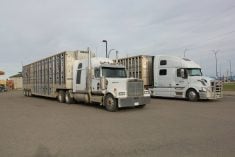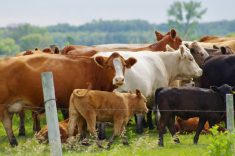A “microbiome” is all the microbes (bacteria, fungi, viruses and their genes) living in a specific environment, and how they all interact with each other. Animals have several microbiomes. There’s an oral microbiome (the mouth and all the microbes in it), as well as nasal, respiratory, rumen, intestinal, vaginal, rectal and skin microbiomes. The various microbiomes interact with each other as well as the host animal.
Animals are outnumbered by these microbial tenants. I call myself a human, but most of me isn’t. If I could separate all the cells in my body into a pile of human cells and a pile of microbial cells, the pile of microbial cells would be bigger. That’s also true of you, and it’s even more true with cattle, because the rumen and large intestines are giant microbial fermentation vats.
The key point about the “microbiome” is that the microbes and animal cells interact with each other and the environment they’re in. That’s most obvious when microbial populations are imbalanced. Bovine respiratory disease, rumen acidosis, bloat and liver abscesses are all examples of an out-of-kilter microbiome.
Dietary changes can temporarily shift microbial populations, but permanently changing an established microbiome is very challenging. That’s one reason why so many commercial probiotics intended to “fix” or improve the microbiome need to be fed continuously (and have inconsistent results).
Read Also

The Canadian Cattle Association’s international advocacy efforts
Global ag policies affect Canadian food policy, so the Canadian Cattle Association participates in international and domestic forums
It may be more effective to intervene early in life, while the various microbes are still sorting themselves out. That’s where much of the microbiome research is currently focused.
Nilusha Malmuthuge (Agriculture and Agri-Food Canada’s Lethbridge Research Centre) and Leluo Guan (University of British Columbia) recently reviewed the state of cattle microbiome science (Impact of maternal health and nutrition on the microbiome and immune development in neonatal calves; doi.org/10.3168/jds.2024-24835).
What they did: They reviewed and summarized scientific publications about microbiome development in humans, lab animals and livestock. There are undoubtedly differences between species, but there are also common principles that apply across species.
What they learned: The microbiome begins to develop much sooner than I thought.
Research comparing the offspring of mice with a normal microbiome to the offspring of germ-free mice found that normal development of the immune system depends on early colonization of the microbiome. Newborn calves are obviously exposed to a huge range of microbes from both the dam (both the udder and colostrum) and the environment they are born in. In the first few hours of life, colostrum bypasses the calf’s rumen and travels directly into the small intestine. The intestinal lining has a lot of specialized cells. Some of these specialized cells absorb maternal antibodies from the colostrum that protect the calf from disease. Other cells provide sites where microbes can begin to colonize. These microbes appear to help the calf absorb the maternal antibodies. Like the mouse studies, it appears that the microbes and the calf’s immune system each influence how the other develops. Exactly how this happens isn’t known, but it seems likely that the calving environment (e.g., open pasture versus calving shed), season (e.g., frozen ground versus mud) and pen conditions (sloppy versus dry ground or well-bedded) will affect how the microbiome and immunity develop in the calf’s gut and respiratory tract.
Calving also influences the microbiome. In normal calvings, the oral and respiratory microbiomes are “seeded” as the calf passes through the birth canal. But difficult calvings may cause even more problems than we already knew about. In humans, prolonged labour increases the likelihood of microbiome-linked disorders in the child. These include allergies, asthma, autism, colorectal cancers, diabetes, diarrhea, eczema, inflammatory bowel disease and obesity. Time will tell whether calving problems predispose calves to things like scours, reproductive disorders, bovine respiratory disease or liver abscesses.
Pregnant cow nutrition is also a factor. The foundation for a healthy microbiome starts long before birth. In humans, studies have shown that the levels of fat, fruit, vegetable oils and specific dietary fatty acids the mother consumes during pregnancy can influence the immune system, microbiome and health outcomes (especially allergies) of their children. In pregnant cows, research has shown that the vitamin and mineral program can influence the size and composition of the gut microbiome the calf develops after birth, possibly by influencing the microbes found in the colostrum. The pregnant cow’s diet can also affect how the calf’s immune system responds to vaccines both before and after weaning.
Bottom line: Stay tuned. Ongoing research will clarify whether measurable changes in the composition of the newborn calf’s microbiome have practically and economically meaningful effects on the calf’s long-term health, growth, fertility or longevity.
So what does this mean to you? While we’re waiting for those answers, use what you already know. Pay careful attention to your winter-feeding program and cow body condition score. Those will help the fetal calf develop normally, reduce the risks of calving difficulty and produce nutritional colostrum with lots of antibodies. These will help give calves a good start in life. Some calves will still need help. Over half of all preweaning calf deaths happen in the first 24 hours of life. Our Calf 911 resources can help you get distressed calves through that critical period (beefresearch.ca/topics/calving-calf-management). At today’s prices, time spent to find and save a few extra calves is likely worth the effort, even if they may not make quality replacements.
The Beef Cattle Research Council is a not-for-profit industry organization funded by the Canadian Beef Cattle Check-Off. The BCRC partners with Agriculture and Agri-Food Canada, provincial beef industry groups and governments to advance research and technology transfer supporting the Canadian beef industry’s vision to be recognized as a preferred supplier of healthy, high-quality beef, cattle and genetics. Learn more about the BCRC at beefresearch.ca.

















